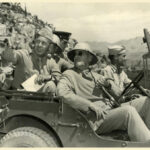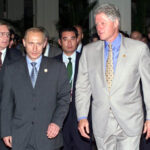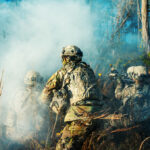
General Gary Brito, the 18th and final commanding general of the U.S. Army Training and Doctrine Command (TRADOC), is in the studio to discuss the Army’s ongoing “continuous transformation.” He sits down with Editor-in-Chief JP Clark to examine the ambitious process led by Secretary of the Army Dan Driscoll and Chief of Staff of the Army Randy George. They also discuss the TRADOC merger with the Army Futures Command to form the new Transformation and Training Command, or T2COM. Driven by the quickly evolving modern battlefield and advancements of adversaries, General Brito emphasizes that success depends on professional leaders at all levels driving change to ensure the Army is ready to fight and win.
We’re going to make no decision, not introduce any new idea without understanding the enemy first
Podcast: Download
Gary Brito is a general in the U.S. Army and the 18th and final Commanding General, United States Army Training and Doctrine Command (TRADOC). Commissioned as an Infantry Officer through Penn State University he entered active duty in March 1987. General Brito has had multiple deployments to Iraq and Afghanistan, and has served in a variety of command and staff assignments throughout his career including the U.S. Army’s 49th Deputy Chief Staff, G-1; Commanding General, Joint Readiness Training Center (JRTC) and Fort Polk; and Deputy Commanding General for Sustainment, then later Operations, 25th Infantry Division.
JP Clark is an associate professor of military strategy teaching in the Basic Strategic Art Program. He served in the army for twenty-six years as an armor officer and strategist. He holds a Ph.D. and M.A. in history from Duke University, an M.S.S. from the Army War College, and a B.S. in Russian and German from West Point. He is the author of Preparing for War: The Emergence of the Modern U.S. Army, 1815-1917 (Harvard, 2017). He is currently working on a history of U.S. military strategy in the Pacific from 1898 to 1941 that is under contract with the University Press of Kansas. He is the 3rd Editor-in-Chief of War Room.
The views expressed in this presentation are those of the speakers and do not necessarily reflect those of the U.S. Army War College, U.S. Army, or Department of Defense.
Photo Description: Gen. Gary M. Brito, U.S. Army Training and Doctrine Command, commanding general, delivers a presentation during the first day of the annual Maneuver Warfighter Conference, Sept. 9, 2025, in Marshall Auditorium at Fort Benning, Georgia. The annual Maneuver Warfighter Conference gathers U.S. Army senior leaders and subject-matter experts from across the globe to discuss the way forward for maneuver forces.
Photo Credit: U.S. Army photo by Joey Rhodes II




Really enjoyed the outstanding discussion. The Restructure /Reshaping operation of the Army is a challenge that leadership at all levels need to take a hold of and work out. We must be able to look past the 25 meter target (now) and plan for the 300 meter target (future) of our force and consider the Army of 2040 with reference to people, and equipment.
If “armies are swept along by the same currents that effect all human institutions: political, economic, demographic, technological, and intellectual forces.” And:
If “each professional generation is more a product of its time, more so than a creation of military institutions.” And:
If “we must understand the contemporary society if we are to untangle the inner workings and character of an Army,”
Then — as to these such observations/suggestions/truths (which I believe I found at the Prefix of COL [ret.] J.P Clark’s book “Preparing for War: The Emergence of the Modern U.S. Army, 1815–1917”) — (a) what are the exact political, economic, demographic, technological and intellectual currents of today, (b) what, thus, defines “our current time,” likewise, (c) what defines “contemporary society” today and (d) can we explain both (1) the transition to Transformation and Training Command — and (2) what is expected to go on there — this, (3) via these exact such matters? (Please do so.)
My question above possibly stated another way: If the Progressive Era explains/explained the emergence of the modern U.S. Army, 1815-1917, what era (expound please as to my three quoted items provided above) explains — or is likely to explain — the emergence of what our Army will look like, and will act like, today and going forward?
Hello JP,
Well done. Really well done. Thank you General Brito for sharing everything and not holding back.
Thank you both for your service and commitment to the American people!
John